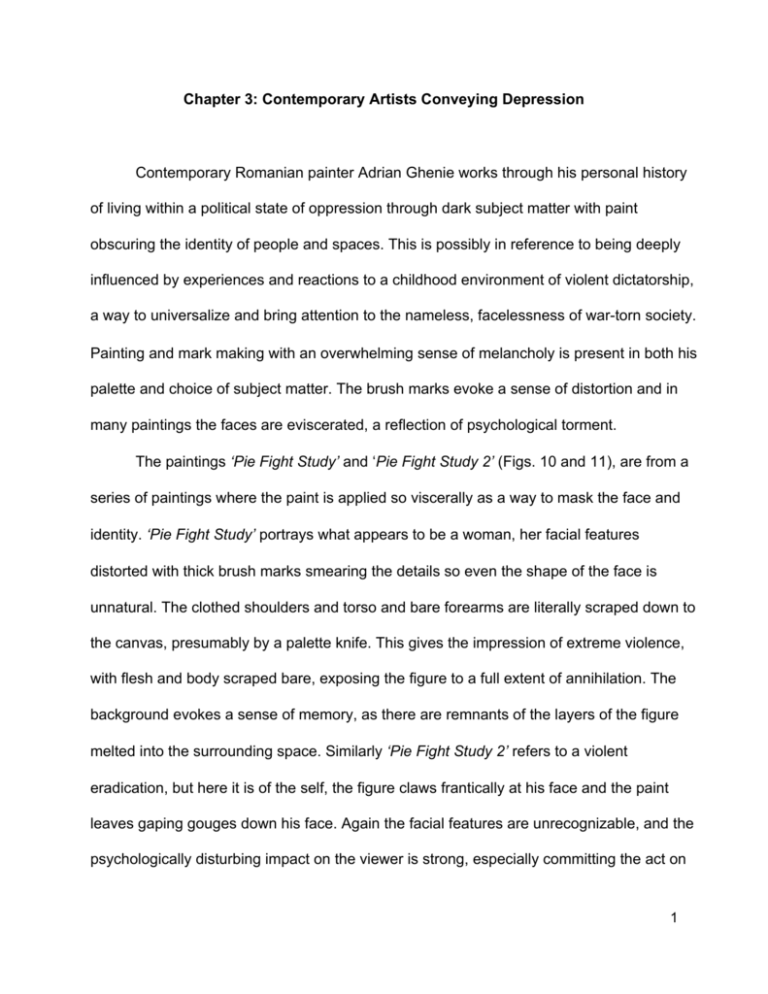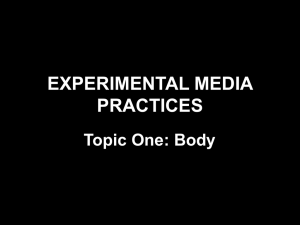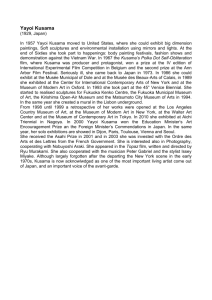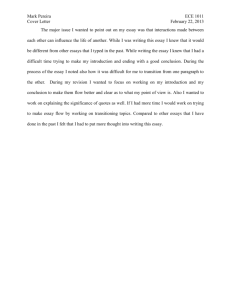Chapter 3 - Jill Christine Miller
advertisement

Chapter 3: Contemporary Artists Conveying Depression Contemporary Romanian painter Adrian Ghenie works through his personal history of living within a political state of oppression through dark subject matter with paint obscuring the identity of people and spaces. This is possibly in reference to being deeply influenced by experiences and reactions to a childhood environment of violent dictatorship, a way to universalize and bring attention to the nameless, facelessness of war­torn society. Painting and mark making with an overwhelming sense of melancholy is present in both his palette and choice of subject matter. The brush marks evoke a sense of distortion and in many paintings the faces are eviscerated, a reflection of psychological torment. The paintings ‘Pie Fight Study’ and ‘Pie Fight Study 2’ (Figs. 10 and 11), are from a series of paintings where the paint is applied so viscerally as a way to mask the face and identity. ‘Pie Fight Study’ portrays what appears to be a woman, her facial features distorted with thick brush marks smearing the details so even the shape of the face is unnatural. The clothed shoulders and torso and bare forearms are literally scraped down to the canvas, presumably by a palette knife. This gives the impression of extreme violence, with flesh and body scraped bare, exposing the figure to a full extent of annihilation. The background evokes a sense of memory, as there are remnants of the layers of the figure melted into the surrounding space. Similarly ‘Pie Fight Study 2’ refers to a violent eradication, but here it is of the self, the figure claws frantically at his face and the paint leaves gaping gouges down his face. Again the facial features are unrecognizable, and the psychologically disturbing impact on the viewer is strong, especially committing the act on 1 oneself. The background is cold and industrial, contributing structurally to the feeling of unease and horror. Ghenie’s paintings shift between historical facts and imaginative construction as a visual representation of fragmentation in response to experiences of trauma.1 Many of his paintings deal with the psychological space that surround and envelop his figures. “By means of a painterly language that ranges from the grotesque to the sublime, Ghenie navigates through the figurative and the abstract to a place that is both existential and metaphysical­a psychological and yet deeply material portrayal of the human condition in which the baggage of history weighs heavily on the shoulders of the present.”2 Linking the aspects of self and place allows Ghenie to express emotion not only through these conditions, but with the added dimension of the psychological interaction and how this reverberates through the paintings. Distortion of self has been expressed in visual and literary works. In writer Susanna Kaysen’s 1993 memoir ‘Girl, Interrupted’ she describes her journey through mental illness and institutionalization at McLean Hospital in Boston from 1967­1968. Kaysen uses metaphors from poetry and art throughout her memoir. The point of her breakdown occurs through her reaction to viewing the 1659 Johannes Vermeer painting ‘Girl Interrupted at Her Music Lesson’ (Fig. 12) at the Frick Museum in New York City.3 “Something also was happening to my perceptions of people. When I looked at someone’s face, I often did not 1 ‘S.M.A.K.: Adrian Ghenie’, smak.be/tentoonstelling.php?id=494&la=en, (Accessed November 3, 2012). 2 ‘Adrian Ghenie (Artist) in Berlin (Germany) from Re­title.com’, Price, Matt, http://www.re­title.com/artists/ADRIAN­GHENIE.asp, (Accessed November 3, 2012). 3 ‘Borderline Personality: Autobiography and Documentary in Susanna Kaysen’s Girl, Interrupted’, Adams, Timothy Dow, Life Writing, (2007) (p. 134). 2 maintain an unbroken connection to the concept of a face. Instead of seeing too much meaning, I didn’t see any meaning.”4 Vermeer’s painting depicts a domestic household scene of a girl not focused on what is expected of her, and this is an accurate reflection for Kaysen regarding expectations of her path as a young woman in 1960s America. Kaysen viewed this painting at a time when its impact was so significant it formed a powerful relationship between herself and the startled girl. Officially diagnosed with borderline personality disorder5, an interesting aspect of Kaysen’s experience is her consciousness of misperceptions of reality, and this clarity helps her feel grounded, “I wasn’t simply going nuts, tumbling down a shaft into Wonderland.” 6 Another author suffering from this disorder is Rachel Reiland, who describes her traumatic experiences from her 2004 memoir, “I couldn’t trust my own emotions. Which emotional reactions were justified, if any? And which ones were tainted by the mental illness of BPD? I found myself fiercely guarding and limiting my emotional reactions, chastising myself for possible distortions and motivations”.7 Here again is the idea of ‘Alice in Wonderland’, of a girl struggling with the boundary of sanity and what constitutes ‘crossing over’. The experiences of mental illness provides these authors the insight and emotional understanding to write without reservation poignant explorations into their very 4 ‘Girl, Interrupted’, Kaysen, Susanna, Vintage, (1993) (p. 41). ‘Mayo Clinic: Borderline Personality Disorder’, http://www.mayoclinic.com/health/borderline­personality­disorder/DS00442, (Accessed November 20, 2012). Borderline personality disorder (BPD) is a mental health disorder that generates significant emotional instability. This can lead to a variety of other stressful mental and behavioral problems including a severely distorted self­image,feelings of worthlessness, of being fundamentally flawed, anger, impulsiveness and frequent mood swings which may push others away, even though if there is a desire to have relationships. 6 ‘Girl, Interrupted’, Kaysen, Susanna, Vintage, (1993) (p. 41). 7 ‘Get Me Out of Here: My Recovery from Borderline Personality Disorder’, Reiland, Rachel, Hazelden, (2004) (p. 37). 5 3 identity. Another artist with strong connections to ‘Alice in Wonderland’ is Japanese painter, sculptor and performance artist Yayoi Kusama, who has even referred to herself as a contemporary Alice. She says of her work, “My art originates from hallucinations, I translate the hallucinations and obsessional images that plague me into sculptures and paintings, the products of obsessional neurosis and are therefore inextricably connected to my disease.”8 She embodies the archetypal Alice teetering on the edge of sanity and how her glimpses to the other side are expressed through dots manifested from hallucinations. The recurring theme of self obliteration in Kusama’s work originated in hallucinations from childhood when a patterned tablecloth visually took over everything she viewed, including her body and universe. She explains, “I felt as if I had begun to self­obliterate, to revolve in the infinity of endless time and the absoluteness of space, and be reduced to nothingness.” 9 This constant representation of self fragmentation is apparent through her famous infinity net paintings and her compulsive obsession with dots.10 Kusama visualizes and performs in a world created through hallucinations in her 1968 video ‘Self Obliteration’, (Fig. 13) a 24 minute visual odyssey into her manic world of dots and nets she has manifested throughout her life through paintings, drawings, performance art and video. The imagery is vibrant and strongly features her paintings superimposed over video images of landscapes with figures in nature and city life, continually inundated with the application of dots. The psychedelic colors and guitar 8 ‘Yayoi Kusama’, Turner, Grady, Bomb, (1999) (p. 64). ‘Fortress of Shooting Stars’, Kusama, Yayoi & Munroe, Alexandra, Grand Street, (1995) (p. 32). 10 ‘Psychoanalysis and the Image: Transdisciplinary Perspectives’, Pollock, Griselda, Blackwell Publishing, (2006) (p. 132). 9 4 soundtrack pulsate with the dots, enabling viewers to connect with Kusama’s hallucinogenic, chaotic mental state. Using a variation in ways to express her world, including the speeds in which the images and video frames are shown, she shows her world where obliteration is everywhere, in nature, the city; a constant and inescapable force. Irish artist Cecily Brennan uses the body as an inquiry into psychological suffering through mediums including painting, drawing and video.11 This concept is expressed in the 2005 video piece ‘Melancholia’ (Fig. 14) through an eleven minute video where black bile seeps slowly from a vulnerable, female figure, huddled in an enclosed coffin­like space. Her only reaction is blinking her eyes, an accurate representation of the physical effects a melancholic state can impose on the body, time seems to slow and the body has no energy to physically move. Drowning in her misery she contemplates in utter hopelessness while in a paralyzed, catatonic state of sadness. Using the medium of watercolor, ‘Melancholia’ (Fig. 15) from the 2007 series ‘Unstrung’, again uses the black bile metaphor. Here the bile is black watercolor that completely obliterates the woman’s face and permeates the paper. A review of this series notes, “They hide from an unseen gaze­behind hands drawn up to faces, buried into and merging with pools of ink, if a face is hiding or being wiped out here and whether the impulse to hide is not also an impulse to hide from oneself, to wipe oneself out.”12 Much of Brennan’s work addresses other psychological issues as well, including sadness, trauma and suicide. These artists are a segment of artists currently delving into the world of depression 11 12 ‘Belfast: Cecily Brennan at Ormeau Baths Gallery’, Mullen, Siobhan, Circa, (2005) (p. 102). ‘Cecily Brennan’, Irvine, Jaki, Art Monthly, (2007) (p. 20). 5 and reinventing interpretations of melancholia. Written autobiography provides the inner workings of mental states on a more immediate and straightforward level, and this aspect is important in looking at depression to gain a more complete understanding. Depression affects people differently, in many cases profoundly for artists as evidenced in the vast, effective ways they have found to emphasize their experiences. The next chapter focuses on my studio practice and how research into historical and contemporary ways of expressing depression have influenced my artistic process, especially in how I am applying my experiences into my work and subject matter. 6 Bibliography Books: Faerna, Jose Maria. Munch. New York: Harry N. Abrams, Inc., 1995. Freud, Sigmund. Mourning and Melancholia. London: Hogarth Press, 1917. Holt, Elizabeth Gilmore. From the Classicists to the Impressionists: Art and Architecture in the 19th Century. London: Yale University Press, 1986. Honour, Hugh. Romanticism. London: Pelican, 1981. Jamison, Kay Redfield. Touched with Fire: Manic­Depressive Illness and the Artistic Temperament. New York: Simon and Schuster, 1996. Kaysen, Susanna. Girl, Interrupted. Cambridge: Vintage, 1993. Kristeva, Julia. The Portable Kristeva. New York: Columbia University Press, 2002. Landau, Ellen G. Jackson Pollock. London: Thames and Hudson, 2005. Nettle, Daniel. Strong Imagination: Madness, Creativity and Human Nature. Oxford: University Press, 2001. Pollock, Griselda. Psychoanalysis and the Image: Transdisciplinary Perspectives. Malden: Blackwell Publishing, 2006. Prokopoff, Stephen. The Prinzhorn Collection: Selected Works from the Prinzhorn Collection of the Art of the Mentally Ill. Illinois: University of Illinois Press, 1984. Reiland, Rachel. Get Me Out of Here: My Recovery from Borderline Personality Disorder. Center City: Hazelden, 2004. Upstone, Robert. The Sketchbooks of the Romantics. New Jersey: Wellfleet Press, 1991. Vaughan, William. Romantic Art. London: Thames and Hudson, 1978. Articles: Adams, Timothy Dow. ‘Borderline Personality: Autobiography and Documentary in 7 Susanna Kaysen’s Girl, Interrupted.’ Life Writing, Vol. 1, No. 2 (2005). Bell, Richard H. ‘Giacometti’s Art as a Judgment on Culture.’ The Journal of Aesthetics and Art Criticism, Vol. 47, No. 1 (1989). Bradbury, Mary. ‘Freud’s Mourning and Melancholia.’ Mortality, Vol. 6, Issue 2 (2001). Britton, Piers. ‘“Mio Malinchonico, O Vero... Mio Pazzo”: Michelangelo, Vasari and the Problem of Artists’ Melancholy in Sixteenth Century Italy.’ The Sixteenth Century Journal, Vol. 34, No. 3 (2003). Cooke, Pat. ‘Kilmainham Gaol: Confronting Change.’ Irish Arts Review, Vol. 23, 175th Anniversary of the Office of Public Works (2006). Drabkin, I. E. ‘Remarks on Ancient Psychopathology.’ The University of Chicago Press, Vol. 46, No. 3 (1955). Hobbs, Robert C. ‘Early Abstract Expressionism and Surrealism.’ Art Journal, Vol. 45, No. 4 (1985) Irvine, Jaki. ‘Cecily Brennan.’ Art Monthly, Issue 306 (2007). Karp, Diane. ‘Madness, Mania, Melancholy: The Artist as Observer.’ Philadelphia Museum of Art Bulletin, Vol. 80, No. 342 (1984). Kristeva, Julia. ‘On the Melancholic Imaginary.’ New Formations, No. 3 (1987). Kusama, Yayoi and Munroe, Alexandra. ‘Fortress of Shooting Stars.’ Grand Street, No. 53 (1995). Levine, Edward and Pollock, Jackson. ‘Mythical Overtones in the Work of Jackson Pollock.’ College Art Association, Vol. 26, No. 4 (1967). Micale, Mark S. ‘The Salpêtrière in the Age of Charcot: An Institutional Perspective on Medical History in the Late Nineteenth Century.’ Journal of Contemporary History, Vol. 20, No. 4 (1985). Midttun, Birgitte Huitfeldt. ‘Crossing the Borders: An Interview with Julia Kristeva.’ Hypatia, Vol. 21, No. 4 (2006). Mullen, Siobhan. ‘Belfast: Cecily Brennan at Ormeau Baths Gallery.’ Circa, No. 113 (2005). Thompson, Clara. ‘The Different Schools of Psychoanalysis.’ The American Journal of Nursing, Vol. 57, No. 10 (1957). 8 Todd, J. ‘The Syndrome of Alice in Wonderland.’ Canad Med Assoc J., Vol. 73 (1955). Turner, Grady. ‘Yayoi Kusama.’ Bomb, Vol. 66 (1999). Umland, Anne. ‘Capturing Giacometti’s Gaze’. MoMA, Vol. 4, No. 8 (2001). Vernon, McCay and Baughman, Marjie L. ‘Art, Madness and Human Interaction.’ Art Journal, Vol. 31, No. 4 (1972). Werschkul, Hilda. ‘Rothko, Melancholia and the Spiritual Promise of the Baroque.’ New England Review, Rev. 32, No. 2 (2011). Websites: ‘Mayo Clinic: Borderline Personality Disorder’, http://www.mayoclinic.com/health/borderline­personality­disorder/DS00442, (Accessed November 20, 2012). Price, Matt, ‘Adrian Ghenie (Artist) in Berlin (Germany) from Re­title.com’, http://www.re­title.com/artists/ADRIAN­GHENIE.asp (Accessed November 3, 2012). ‘S.M.A.K.: Adrian Ghenie’, http://smak.be/tentoonstelling.php?id=494&la=en, (Accessed November 3, 2012). 9 (Fig. 11) Adrian Ghenie, ‘Pie Fight Study’, oil on canvas (40 x 50 cm) (2012). 10 (Fig. 12) Adrian Ghenie, ‘Pie Fight Study 2’, oil on canvas (55 x 59 cm) (2008). 11 (Fig. 13) Johannes Vermeer, ‘Girl Interrupted at Her Music Lesson’, oil on canvas (39.4 x 44.5 cm) (1658­59). 12 (Fig. 14) Yayoi Kusama, ‘Self Obliteration’, video (1968). 13 (Fig. 15) Cecily Brennan, ‘Melancholia’, video (2005). 14 (Fig. 16) Cecily Brennan, ‘Melancholia’, watercolor on paper (55 x 75 cm) (2006). 15







